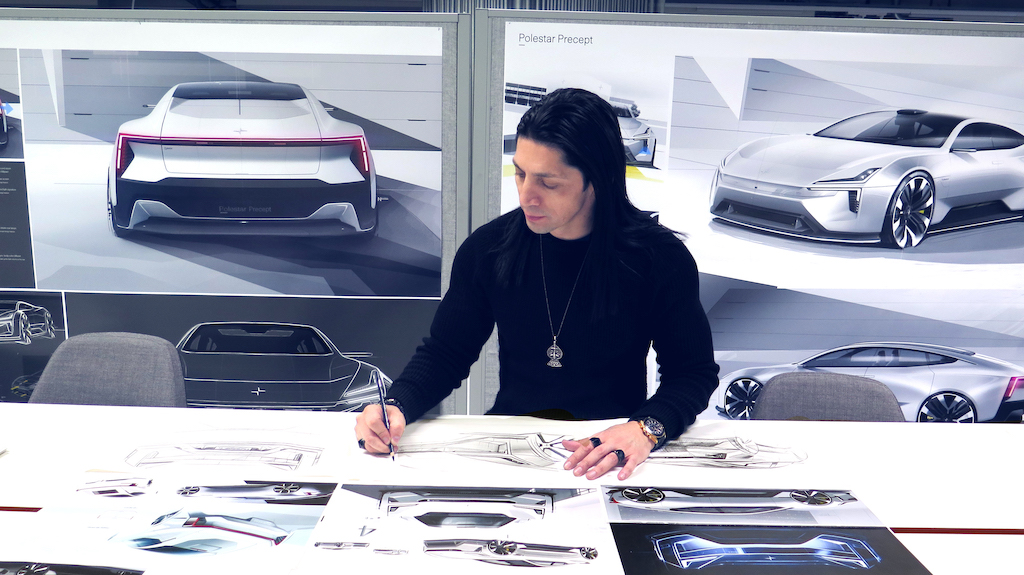Polestar has established itself as a major player in the premium electric car market, with impressive sales figures placing them in the top five, and even the top three for commercial vehicles. With the release of their new high-performance SUV, Polestar 3, the company is looking to continue their success. To gain some insight into the design process, we sat down with Nahum Escobedo, exterior design manager for Polestar 3.

Nahum Escobedo’s all-black attire, from his necklace down to his leather bracelet, seems to be a typical style among architects, interior designers, and car designers. “There’s no specific reason behind it,” Nahum laughs. “It’s just practical. I don’t have to worry about matching anything.” This practicality extends to his design philosophy, which is rooted in the lessons he learned from his father. “My father was a mechanic who loved to tinker with cars, especially hot rods,” Nahum explains. “I grew up with a deep appreciation for muscle car culture. My father loved building engines and I enjoyed working on the outside. We often talked about how great it would be if he built an engine and I did the exterior around it.”

During your upbringing, did you also work on the car mechanics with your father?
Nahum Escobedo: “Absolutely. If I wanted to help him, I had to master the basics. My father taught me from a young age that it’s better to learn the basics so that you can work on your car yourself, rather than always taking it to a mechanic.”

What inspired you to design the new Polestar 3?
Nahum Escobedo: “As a child, I was always fascinated by airplanes. During the design process of Polestar 3, our new electric, high-performance SUV, we were sitting in the wind tunnel when that fascination resurfaced. Airplanes are supposed to be incredibly aerodynamic, but I started to think about what it is that I love about them. It dawned on me that everything about airplanes is flat. But, of course, certain designs have specific functions. For example, as car designers, we used to design large openings to cool the combustion engine. Now that we’re moving away from that, we face different challenges and have to design differently. I drew on my inspiration from aviation to close the unnecessary openings and create something else. So, for Polestar 3 we closed the openings and installed cameras, a radar, heating wires, accelerometers, and ultrasonic sensors that allow the car to monitor the road ahead. The result is the SmartZone, which turns “breathing” into “seeing.” Nowadays, we have to design cars much more conscientiously.”

What do you mean by “designing more conscientiously”?
Nahum Escobedo: “As designers, we have to think about sustainability and how it can be reflected in the car’s exterior. From the very beginning of the sketching process, I focus on how I can make an impact. I explore how we can use and integrate materials in a way that allows us to extract and recycle them at the end of the car’s life cycle.”

“Polestar is a new and entirely independent brand, with no ties to anything. So we have a lot of freedom to experiment.”

In the near future, do you expect that electric cars will no longer have a grille and will be made of recyclable materials?Nahum Escobedo: “In this era, where every brand seeks to differentiate themselves, some still consider it important to have openings, while others hold onto their heritage traditions. Polestar is a new brand with no ties to anything. We have the freedom to define our own path and experiment.”

You have worked as a designer for Honda and Volkswagen. Does this “lack of ties” make your job as a designer easier at Polestar?
Nahum Escobedo: “With electrification, we face new challenges, and I enjoy tackling challenges. At Polestar, the culture of the community is fascinating because every team, whether it’s engineering or branding, is incredibly passionate. I feel like I am in the right place at the right time, and I wouldn’t trade it for any other company.”

Speaking of the right time, it seems like designers today face a lot of stress and pressure due to the fast pace of innovation. What are your thoughts on this?
Nahum Escobedo: “Personally, I don’t view design as just a job; it’s my hobby and passion. I think it’s important to love what you do. If I were 25, I would perhaps think differently, but with my past experiences in art and working with other car companies, I really enjoy what I’m doing right now. In fact, if I could go back in time, I would still choose this period of time, today.”
You just mentioned your past experiences with art, could you elaborate on that?
Nahum Escobedo: “Part of my studies were focused on art, but even before then, I spent a lot of time painting. I enjoy sculptures, architecture, and artists like Michelangelo and Van Gogh. I try to incorporate Vincent’s emotional and passionate style into my work. While I love and appreciate grand master sculptures, my personal interior design style leans more towards Scandinavian design, which I also love a lot.”

What do you think is the best thing about Polestar 3?
Nahum Escobedo: For me, it’s the car’s unique architecture. Polestar 3 is a sculptural SUV with a low, distinct roofline, redefining the traditional SUV concept. Despite this, the car’s interior offers ample space. This design choice has several benefits, including improved aerodynamics, a low, sports car-like SUV that handles like one, and an emphasis on the car’s stance. We made sure to keep the body and wheelbase wide, creating a spacious front and second-row seating area. Designing an SUV was crucial to me because it offers space and the possibility to develop something akin to a sports or performance car. Polestar 3 is all about aesthetics, attitude, and sculpture. Its minimalist Scandinavian design and driving dynamics make it feel like a real sports car.



